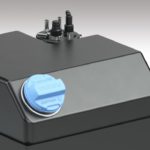AdBlue can be quite the troublemaker when it comes to the influx of calls that the Volvo CE technical support team receives each day.
Customers call with a wide array of issues, but a common-engine related call involves AdBlue. Poor handling, accidentally putting it into the diesel tank, and contamination are common occurrences, and these hiccups can cause severe damage to your equipment, incurring high costs of repair in the process.
Prevention is better than cure, so heed the below advice for how to avoid such issues…
Feeling blue?
AdBlue is a solution made for emissions control, by reducing nitrogen oxide emissions in diesel engines. It’s a liquid, similar in appearance to water, and is sprayed into the exhaust before it leaves the machine.
Proper handling is essential to avoid any AdBlue-related problems. It’s always advisable to follow manufacturer instructions, so take note of these prior to handling. AdBlue should be stored in a cool, dry location out of direct sunlight, and preferably indoors in stainless steel or plastic containers. It’s important to note that AdBlue will freeze below -10ºC, turning it slushy, but this does not impede performance or quality. If it’s going to be kept somewhere cold, ensure that you have an expandable container, as its volume increases by 7% once it hits freezing. Although AdBlue naturally degrades over time, it can last up to one year.
Never mix your drinks
One of the most important things to stress is that AdBlue should never be mixed with diesel. If an operator starts a machine with AdBlue in the fuel lines, the machine can be severely damaged, incurring big repair bills.
This confusion can occur easily as fuel and AdBlue tanks are near one another on some pieces of construction equipment. However, it’s vital to remember that AdBlue has its own filling port. The cap for the AdBlue tank is blue and the size of the fill hole tends to be smaller in diameter than the fuel hole.
Prevention is always better than cure, so if you are ever in doubt that the correct filling port was used, drain and flush the tank with deionised water or clean AdBlue fluid to avoid potential damage. Communication is important, so let your operators know that they should immediately contact you and your Volvo dealer if they accidentally add AdBlue to the fuel tank. These things happen: but your dealer can provide advice on preventing further damage and remedying the issue.
Good to remain pure
Absolute purity is essential for AdBlue to do its job best, making it vulnerable to contamination. Contaminants can easily get into the fluid through the tank cap area, which can lead to damage and consequently long, unplanned downtime for the machine. Dirt and dust can easily get washed down into the tank from the fill cap area if it isn’t cleaned thoroughly before fluid is added. Talk to your operators and maintenance staff to let them know it is super important that contamination is avoided and that cleaning around the cap before use is vital. As is storing AdBlue in a dedicated container. Don’t use containers that have been used for other materials or fluids – even if they’ve undergone a thorough cleaning. AdBlue really is that sensitive to contamination.
An indicator that your AdBlue may be contaminated is an uptick in AdBlue consumption, a selective catalytic reduction (SCR) system malfunction, or quite simply, the engine shuts down. The ideal concentration of urea-based AdBlue is 32.5-37%. These problems may occur if this ratio is off, indicating a contamination. To test and monitor the purity of your AdBlue, use a digital refractometer.
Good to know
The above points are the biggest worries, but there are other issues to bear in mind.
Once the AdBlue tank is empty, a dashboard indicator light will appear and the engine will de-rate after some time. Also, regularly change AdBlue filters according to service intervals and bear in mind that AdBlue tanks are prone to a build-up of condensation – and this water can lead to contamination. Topping off the AdBlue tank at the end of the day will avoid this.









